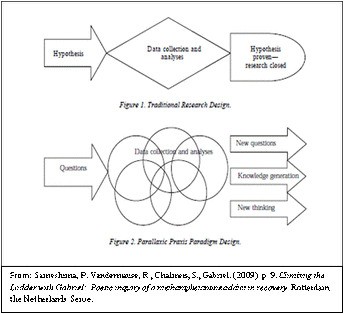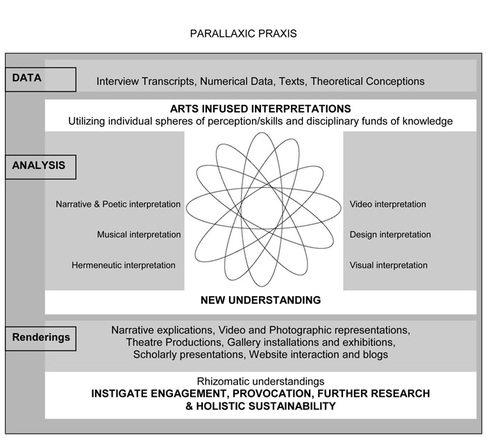Parallaxic Praxis
The guiding structure for this project is parallaxic praxis, a “researching, teaching, and learning design
model...grounded in holistic arts-integrated inquiry” (Sameshima, et al., 2009, p. 10). This model fully embraces hermeneutic phenomenology as demonstrated in the designation of meaning making and the dialogic process as a form of unfolding knowledge production (Sameshima, 2007). The arts are utilized as a means to render understanding by creating thematic and interpretative artifacts, which animate ongoing learning in others. In this study, mediums such as video production, poetry, collage, interpretive narratives, spoken word, musical interpretation, and still photography are applied in the meaning-making process. Further, representations are dialogic when placed alongside other interpretations to form “systems of analysis and interactions in the hybrid nexus spaces” (Sameshima, et al., 2009, p. 10). It is only through “multiple
perspectives and a varied system of representation”, can fuller understanding and rich meaning making be gained (p. 8). Figures 1 and 2 provide a graphic comparison between traditional research designs and parallaxic praxis paradigm design.
As shown in Figure 1, a traditional research model begins with a conditional proposition or hypothesis, which is set forth as an explanation for the occurrence of specified phenomena. Through the process of data collection
and analyses, the hypothesis is addressed - either proven or disproven - and the esearch is closed.
In contrast, Figure 2 depicts the parallaxic paradigm design. In this model the research process commences with questions. The process of data collection and analyses is multilayered and collaborative. The focus of the analysis is on the liminal spaces between the researchers interpretations and systems for meaning-making” (Sameshima, et al, 2009, p. 8). It is through the multilayered and collaborative research methodology that new questions, knowledge generation and new thinking are rendered. While both research methods hav merit and are dependent on the type of research questions asked or hypothesis proposed, use of the parallaxic praxis design is especially beneficial when research questions are open and focused on making meaning of
context and the experience of complex and controversial social phenomena.
Rhizomatic Understandings: The arts are utilized as a means to render understanding by creating thematic and interpretative artifacts, which animate ongoing learning in others. In this study, mediums such as video production, poetry, collage, interpretive narratives, spoken word, musical interpretation, and still photography are applied in the meaning-making process.
Further, representations are dialogic when placed alongside other interpretations to form “systems of analysis and interactions in the hybrid nexus spaces” (Sameshima, et al., 2009, p. 10). It is only through “multiple perspectives and a varied system of representation”, can fuller understanding and rich meaning making be gained (p. 8).
Models reprinted with permission: Dr. Pauline Sameshima


